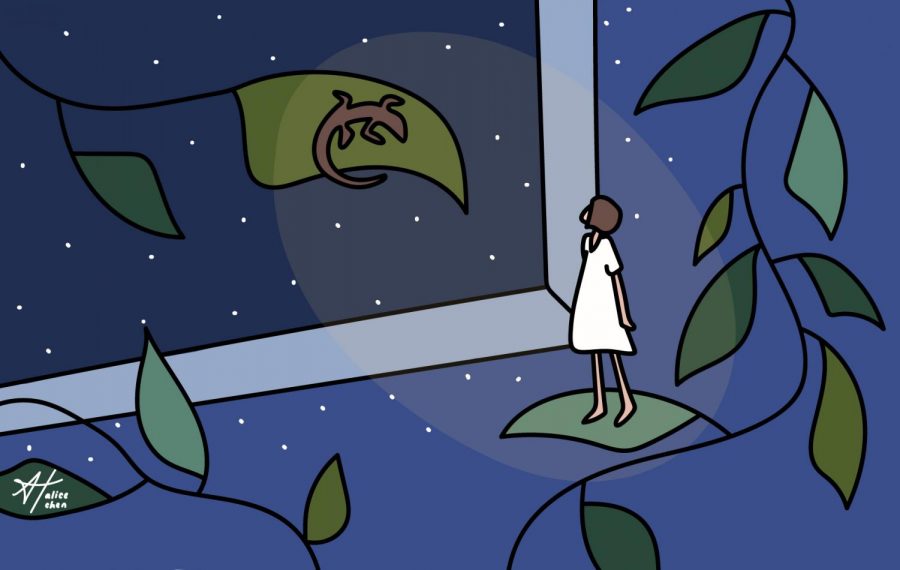Goldstein’s Gold Stars: Reptile Review (and Lunch, Too)
May 15, 2020
Recently, my family has made it a habit (among other, less appealing things) to eat lunch outside. We’re lucky enough to have a pretty large backyard, including a patio covered by a pergola (pretty—albeit termite-infested), and it is there that we spend anywhere from 30 minutes to an hour each day, consuming our midday meal.
We face away from the house as we eat, roughly northeast, towards the somewhat vegetated hill that comprises the backyard. The surroundings are surprisingly saturated with sounds: birds, alarms, power tools, the roar of the 56, the occasional shriek of a child, the ceaseless blast of ’70s music from our neighbors to the south.
Oddly peaceful.
Over the course of the month or so that my family has spent lunch this way, we’ve paid more acute attention to the other inhabitants of our property. Prominent residents and visitors include hawks, hummingbirds, bees, and butterflies, to name a few.
As is common practice, we’ve projected human narratives and personalities on many of them.
We often spot two butterflies, a Monarch and a Mourning Cloak, passing through in a frenzied flurry. Clearly, they’re at war. Whenever we see one without the other, we assume that a victor has emerged following yesterday’s skirmish.
We sometimes see a crow as well, doing anything from sharpening its beak on dead branches (getting ready for a Crow Convention) to hopping along the chain link fence (agility training) to aggressively pecking the ground (the corvid equivalent of facepalming, obviously).
Our most notable denizen is, however, neither bird nor insect.
Edgy Reggie is a Great Basin fence lizard.
Since long before social distancing, fence lizards have been a source of fascination for me. Throughout childhood, I laughed at their assertive push-ups and wondered at their nimble speed. My friends from across the street would come over, and we’d set up lizard traps that were, for the most part, unsuccessful. We’d give up and attempt to grab them with our hands, and when we did, which was rare, we would chortle with glee and revel in the power we had as humans with opposable thumbs and apparent intellectual prowess. Then, we’d let the lizards go.
I once pried a damaged fence lizard from my dog’s mouth. I was surprised: though my dog often pursued lizards, he had never caught one until then. I was also distraught, more so than I had expected. What good were clumsy thumbs and juvenile intellect when you needed a way to keep life from leaking out? I gently placed the dying lizard in a hole up on the hill, out of my dog’s reach, and didn’t bury it until the ants arrived.
As I’ve grown up, however, I’ve spent less and less time in the backyard. With greater responsibilities, expectations and tendencies to stay glued to a screen, I’ve found myself filling free time with other things, mostly leaving this world in favor of the ones found in books, movies, tv shows, songs. Oh, and sleeping.
Now that I’m socially distancing, it’s easier to take care of (or ignore) those responsibilities and expectations, and it’s easier to become bored (or overwhelmed) online. As a result, my visits to the backyard have increased in frequency.
In fact, my whole family spends more time out back, compared to Before. It’s become common to find us napping in the hammock or working outside or simply admiring the flowers (after all, it’s spring!).
It’s become common to find us lingering over lunch outside, too, marvelling over the vast beauty of our little world, over the effortlessly human aspects of inhuman things.
It’s also become common to find us pointing, with a shout—“it’s Reggie!”
The great representative of our western fence lizard population.
Upon our first encounter with him, we were struck by the certain swagger in his walk. Unlike the other lizards, he consistently kept at least one of his legs over the corner of the wall, making it appear as though he was hugging it. He was larger and chunkier than many of the other lizards we’d seen, and his push-ups were filled with an almost stately conviction.
He was a source of much amusement in my family, and his gaze and posture conveyed the sheer extent of his offense at our laughter. He indignantly lifted his head and displayed his cerulean chin that was characteristic of male Great Basin fence lizards. We laughed harder.
He was, in one word, edgy.
The second or third time we saw him during our daily outdoor lunch, we realized he needed a name. My brother, in all of the wisdom associated with an eighth-grader, put forth this declaration:
“Reggie—because he’s edgy.”
Thus, our newly christened reptile became a local source of comedic relief. As far as I know, none of us have thanked him yet, but I think we’re all grateful for the opportunity Reggie’s given us to relieve our pandemic stresses. At least, I am.
In a way, we’ve become kids again. We find inspiration in small things, escape our worries in distractions. We are uplifted by one Great Basin fence lizard.
I give Sceloporus occidentalis longipes five stars out of five.
In addition, I give outdoor lunches five stars out of five.



